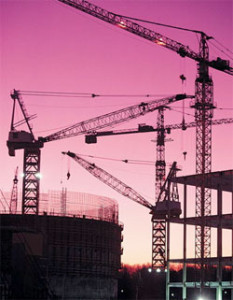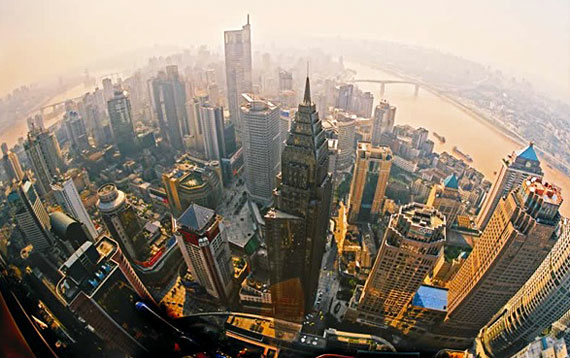As I gazed out my office window into the grey smog covering Chongqing, a city district of 30+ million people in central China, I began to think about the expansion of this economy. Here are my thoughts.
The Chinese government continues the Go West Campaign. It is designed to convince those who are heading into big cities looking for work to go to the western cities and spur the same economic boom that is occurring along the east coast. This includes upgraded and new infrastructure, additional energy generation, and the intensification of natural resource extraction in the western regions.
Every road throughout the nation is being refinished with concrete. From highways to one lane roads that were formerly dirt, nearly every road in every province is being upgraded to allow movement of goods and people at a faster pace. This would account for China’s usage of 45% of the world’s cement year upon year. This is expected to grow at an average annual rate of 8.5% (or 90 million metric tons) during the 2006-2007 period.

Traveling by rail through Sichuan Province and everywhere else, parallel rail lines beside existing lines are being built for rapid transit and high speed delivery of goods and people. From now to 2010 the Chinese government plans to complete an additional 19,800 kilometers of new tracks and up grade 15,000 kilometers of existing routes.
Where development and economic growth compete against environmentalism, conservation always falls on deaf ears. One of the most pristine areas in the western part of Yunnan province is the Nujiang Valley, which will have a series of 13 dams built that will cover a 700 kilometer section of the valley built by Huadian Corporation. This one of the last two major dam-free rivers in China. The 100 billion kilowatts per hour of generated electricity would be for factories on the EAST coast of the country. In addition the power will be used in new factory complexes that are slated to come into the western region to take advantage of tax breaks and special incentives to relocate there.
One of the biggest tourist draws in Yunnan province for trekking is in the Tiger Leaping gorge, but a series of eight dams along a 564 kilometer section of the Jinsha River to provide power will alter the gorge. Lancangjiang Hydropower Development Corporation, a subsidiary of China Huaneng Group states “the dam will have an overall capacity of 20 million kilowatts, it is almost the same size as the Three Gorges Dam, but the water storage capacity in Tiger Leaping Gorge reservoir will be even bigger.” In addition to electricity generation, this dam is supposed to help solve the siltation problem that is threatening to block the Yangtze Three Gorges Dam 1500 kilometers downriver.
The new hydroelectric power sources will be for mining operations in the western portions of China as resource extraction heats up. China’s internal mining capacity will only keep consumption of metals for manufacturing at the break even point. Mining as an industry has seen 20% growth year on year. Antimony and Molybdenum along with Gold, Silver, Copper, Aluminum, Zinc, Nickel and Lead are leading the growth.
Roads leading to the Myannmar border are being expanded to four lanes as new sea ports and oil loading platforms are within easy reach and accessible in the Bay of Bengal from the west of China.
A new natural gas field discovery containing 3.8 trillion cubic meters near Dazhou in the N.E. part of Sichuan Province was instantly slated for smelters, in addition to the hydroelectric power set to come on line.
The new find of oil in Bohai Bay is just a drop in the bucket compared to the needs of this insatiable economy; at best it will add 200,000 barrels per day of production, and that was the amount of new increased oil usage country wide for last year alone.
The Chinese government is giving incentives for recent graduates to relocate, or “population transfer” as its sometimes called, to the second and third-tier cities of the west. Job placement and minimum guaranteed salaries are but a few of the gems offered. Additionally students who use state loans to finish their university studies may have their loans waived. The loan, up to 24,000 yuan (US$4,000) per student, is paid by the Chinese government if the graduate promises to work in a western or remote region for at least three years.
On a recycling note not a single plastic bottle, cardboard box or glass container goes uncollected by the endless stream of individual collectors digging through the road side rubbish bins, back alleys and street curbs looking for the new treasure of China, recyclables. Cities are scoured by collectors daily for anything that can be sold as scrap. I watched as an old apartment building was torn down by hand and a woman emerged from the building with a bag if old light switches. At first I thought she would use the complete switch, but she took out a small hammer and broke them into pieces, carefully separating the copper from the plastic. Recycling is an enormous multi-billion dollar business, gobbling up our western throw away products and growing expodentialy larger every year.
Ethanol production is skyrocketing as the largest ethanol producer China Agri Industries which is the grain-processing unit of Cofco Ltd., China’s largest grain trader is planning to open two more refineries this year, a 100,000 ton project in Hubei and a 300,000 ton project in Liaoning.These projects will use sweet potatoes as the feed stock. An additional 1 million tons of capacity, awaiting permission, will be added by the end of 2008. China Agri is using several different feedstock grains and plant to produce ethanol. As it was explained, diversifying feedstocks reduces the reliance on a single crop in case of crop failures. Sinopec and PetroChina have teamed up with China Agri in the downstream ethanol blending business.
Lastly, as I listen to the never ending car horns below, I remembered reading a recent article stating that an estimated 3000 cars are added to Chongqing’s roads every day and presently 70% of the city’s road space is filled during the day. My own experience of traveling six miles the other day taking me two and a half hours, with 30-40 storey buildings along the entire distance makes me a believer.

There is much talk around the world saying again and again that China’s 8-10% growth rate cannot be sustained, that may be true along the east coast, but as economic productivity flattens out in that part of the country it grows in the west. New land routes to the sea via Myannmar are providing an economic kick start in this region. The boom is in its infancy, and if it turns out anything like the massive growth in the east, the growth will be long and continuous.
Sometimes I talk with expats who moved to Chengdu a decade or so ago. This city has grown from a small hamlet into a more populous city than LA in just this short span of time.
I read somewhere that Chengdu is the fastest developing city in the world! That’s gotta be close to the truth when you look on almost every road in the city and find some kind of construction.
They’ve already laid out plans to upgrade a currently minor road into the 4th ring road. No doubt coming in a few years.